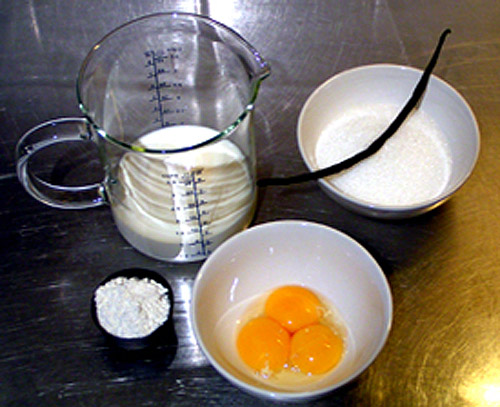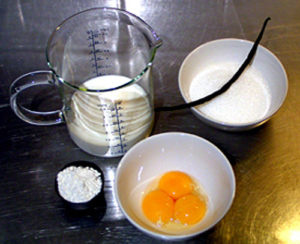
Creme Patissiere / Vanilla Pastry Cream
Creme Patissiere / Vanilla Pastry Cream
Creme Patissiere / Vanilla Pastry Cream
Here I give you 2 quantities of Vanilla Creme. It is an extremely easy recipe and is really useful to know.
Vanilla pastry creme is rarely used as it is. It is normally folded in with whipped cream and then used under strawberries or banana’s in open fruit tarts. It is also used for many traditional French recipes such as Paris-brest, Cream Puffs, what Americans call Napoleons, and the Britt’s call Vanilla Slices.
Creme Patissiere - Vanilla Pastry Cream
Here I give you 2 quantities of Vanilla Creme. It is an extremely easy recipe and is very useful to know. The recipes make 1/4 liter & 1/2 liter of pastry cream.
Ingredients
290 gr or 1 generous cup of vanilla cream
- 1/4 liter milk
- 1/4 vanilla bean slices and seeded or 1 teaspoon vanilla essence.
- 3 egg yolks
- 75 grams plain white sugar
- 20 grams plain white flour weighed
580 gr or 2 1/3 cups of vanilla cream
- 1/2 liter milk
- 1/2 vanilla bean slices and seeded or 1 teaspoon vanilla essence.
- 6 egg yolks
- 150 grams plain white sugar
- 40 grams plain white flour weighed
Instructions
- Have all your ingredients measured and ready to go:

- You will need a saucepan, use a pot that is big enough to hold all the ingredients when assembled. A medium sized whisk, a 1 liter bowl and an electric hand held mixer if you have one. If not then the whisk and a little elbow grease will do.
- Split the vanilla bean length wise and with the tip of a small knife scrap out the seeds and place them and the pod with the milk in a small sauce pan. Bring gently to simmer. Being sure as to not let the milk stick or burn to the bottom of the pot.
- In a small glass or metal bowl beat or whisk the egg yolks and sugar together until it turns pale and forms a ribbon when you move the whisk through the mix.
- Add the flour and gently stir it into the egg and sugar mixture. This will make the mixture considerably stiffer.
- If you did not use a vanilla pod while heating the milk, add the vanilla essence now.
- Remove the milk from the stove and pour 1/3 of the heated milk into the egg and sugar mixture and quickly whisk it in thoroughly. Then you can add the rest of the hot milk.
- Use a clean pot or wash out the one you heated the milk in and pour the milk mixture back into it through a strainer.
- This will remove bits of cooked egg, the vanilla pod and any scum from the milk. This is an important step and must be done.
- Return the mixture to a low heat and bring it back to a very gentle simmer stirring all the time. This should not take more than a few minutes. By the time it comes back to the simmer it should also be quite thick.
- Simmer it for 1 minute more to cook out the flour and fully thicken the mixture.
- It is at this simmering point that it likes to stick and burn to the bottom of the pot. To avoid this which will ruin your creme, stir constantly. You can also use a non-stick pot but you still have to stir to avoid any lumps.
- Remove the creme to a container and cover with plastic wrap making sure that it completely covers the creme to avoid a skin from forming as it cools any place it is exposed to the air.
Notes
The only pitfall I have ever found with this recipe is burning the milk because I was in a hurry and not paying attention. (Only once! Have you ever tried cleaning a pot with burned milk in it?) Or scorching the creme after I got it back in the pan to thicken it. Burning or scorching the milk or creme will affect its taste so pay attention while you’re doing it and you won't have any problems.
Another useful bit of information is why you put only part of the milk into the egg mixture at a time. If you put all the boiling milk in at once you would wind up with scrambled eggs. So you need to understand that by adding 1/3 of the mixture in the beginning you avoid the problem. In the food trade this is called tempering.
Tried this recipe?Let us know how it was!
Leave a Reply